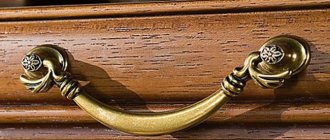While sorting it out in the garage, I discovered a large number of old files. Having restored them with citric acid, I encountered a slight difficulty. Where can you get so many tool handles and how to make a reliable handle for a file?
A solution was found, which I want to share with you.
How to make a rivet from a nail? | The cheapest way to bring a broken knife back to life?
Now everything is correct - you can use it
How and from what to make a handle for a file is not a question - there are always scraps of a wooden block or a handle from an old mop. The main difficulty is where to find crimp rings for the handle, without which the handle will not last long - if it does not crack when inserting a file, it will certainly break a little later.
Thin-walled metal tubes are used for this purpose, but I didn’t have them in stock. But empty plastic bottles caught my eye. The idea immediately formed - to use their necks as pressure rings.
How to restore a screwdriver bit: an easy way
DIY saw handle
Somehow I needed to buy a miter box, but the tool store only had a miter box complete with a miter saw. The miter box and saw were very Chinese, but the urgent need for a miter box forced me to purchase this set. Time passed and I decided to try this Chinese saw at work. After the first pass, the handle of the saw broke and not only broke, but shattered into pieces, and I injured my hand with the sharp edges. Oh, and for a long time I remembered this “wonderful” saw. Some more time passed and I examined the blade itself and decided that it could be useful for precise cuts, and the blade on the saw would make it even. All that remains is to make a new handle for it. And so, the topic of the article is a DIY saw handle.
Making a handle is very simple; for this we need a small piece of plywood 7–9 mm thick, three M3 screws and two M5 screws with nuts, a pencil, a jigsaw, sandpaper, and a drill.
First we need to find out what size the old pen was, for this we collect its fragments and glue them together, maybe not very accurately, only the outline is important to us.
Gluing an old pen
As you can see in the photo, the old saw handle has a weak point, so we will strengthen it in the new handle. Next, we need to make two blanks for a new handle, since it will consist of two halves. To do this, you need to place an old pen on a piece of plywood and draw two contours of our blanks with a pencil. Then, using a jigsaw, you need to cut out two blanks. Then you need to put them together, while ensuring that the dimensions match as accurately as possible. We drill through holes for fastening screws and for mounting screws. We fasten the two halves using M3 screws and process their edges in a yew until they become one whole, without any gaps. It is very good to use sandpaper, since plywood can be easily sanded.
Comments are already disabled on the article: "Do-it-yourself saw handle"
By the way, it is convenient to secure the saw in such handles so that the handle sticks up, sort of like a machine gun, and the teeth of the saw point down. This results in a more natural hand grip and stronger shoulder pressure. I have a friend who even makes handles for knives this way, a kind of reverse grip, he says it’s very convenient.
A pitting saw is like a scalpel in carpentry; it is used for thin and precise cuts, cutting pegs there, glazing beads at the correct angle, so much effort is not applied to it. But for a large saw, a reverse grip is probably better. The “Friendship 2” saw has just such a reverse grip; it requires a lot of force.
User Tools
Site tools
Side panel
Navigation
Social media
Miscellaneous
Content
In the old days, there were no construction supermarkets; the tool was made individually, and the owner “customized” it to suit himself. Now everyone got lazy: he went and bought it. This will not work with a hacksaw handle; it adapts to the owner’s hand for ease of use in the future.
First of all, we need wood. This can be either a board made of certain types of wood or plywood. I just have a sheet of 12 mm thick 3/4 grade left. This thickness is not enough for a handle, so you will have to fold the sheet in half and glue it together. Cut out two rectangles with dimensions slightly larger than the dimensions of the sample handle. The example is my grandfather’s hacksaw, which I use constantly to cut. Fits perfectly in the hand.
Using a brush, cover the glued sides of both parts with PVA glue. The sides are different - beautiful on the outside.
We compress it with clamps and put it in a warm place. This stage should be given special attention; the surfaces must be adjacent to each other over the entire area.
...and use it to cut out the future handle.
We process the handle with a file until it “adjusts” to the hand, then we go through it with P320 sandpaper and cover the entire handle with PVA glue.
After the glue dries, the pile will rise. We clean the entire surface with P500 sandpaper and drill holes for the tension screws (first with a 7 drill for the recessed head, then with a 3 drill).
The handle is ready for installation. The longitudinal cut will be made for a specific blade.
Suppose you have a need to process wood or some kind of wooden product using a hacksaw. There seems to be no difficulty in picking up a hacksaw and starting to work, but you need to clarify which type of tool is suitable for a particular job. There are dozens of models, and their difference is not only in price and manufacturers.
The tool is not complicated to use, but has several nuances that are worth considering. In this article we will try to analyze the main details that you need to pay attention to.
Brief contents of the article:
Preparatory processes
If the prepared blanks are made of walnut or maple, then the wooden handle for them is cut out using a hacksaw. You can also use a regular jigsaw or a small circular saw, which is equipped with a special planing disc. These tools give the most even cut, which will greatly facilitate all subsequent processing.
Important! During the sawing process, it is important to choose the correct angle in relation to the wood fibers. This will help to get a beautiful texture on the cut.
All resulting workpieces are carefully sanded using a special sanding grid or using sandpaper. When carrying out this process, special attention should be paid to the careful adjustment of two wooden blanks relative to each other. This is not a wooden shovel, where the handle is made from one single piece. They should fit very evenly to each other, without forming any gaps. If the edges are a little loosely connected, this is not a problem, since everything can be cut off during subsequent processing.
Drawing of a handle for a file.
After this, take a blade with a bolster previously put on it, place the shank on a piece of wood and outline everything with a pencil. Then, using a regular square, the markings are transferred to the ends of the finished parts, and you get a finished handle for a wooden file or a faucet for a bathhouse.
Once the hole for the shank is completely marked, the drilling process can begin. To do this, you will first have to measure the thickness of the shank and select a drill of exactly the same diameter. When carrying out work at home, it is better to carry out the drilling process using an electric drill, having previously clamped the prepared workpieces in a special vice. Thanks to these actions, you can get two parallel holes, between which a thin partition is formed.
It can be removed using a file or a special tool - a needle file, which. When carrying out this process, you will need to carefully check the degree of relationship between the axes. For this purpose, you will need to put the blanks on the shank several times and grind them from the desired sides.
Canvas size
Depending on your task, you can choose different blade lengths. For simple boards and small bars, a length from twenty-eight to thirty centimeters is quite suitable. If construction work is underway, then it would be wiser to take a canvas from forty-five to fifty centimeters long.
The basic rule: the length of the product should be half the length of the hacksaw itself, otherwise you can forget about ease of use.
Sharpening and tooth size
The size and sharpness of the teeth is one of the main criteria when choosing a hacksaw. The bottom line is that the small teeth on a hacksaw are for fine work and the long teeth are for rougher work, they are well suited for gardening where neatness is not an issue.
By looking at the photo of wood hacksaws with various teeth, you will see which hacksaw is right for you.
In the hacksaw market, there is a TPI unit, on which the cutting accuracy directly depends; it determines the number of teeth per 1 inch. For example, you need to cut a couple of chipboard boards, in this case it is recommended to use hacksaws with a TPI in the range of seven to nine, then the cut will be smooth and neat.
If you need to work in the garden, cutting down branches, for example, then accuracy is not so important; a hacksaw with a TPI of three to six will suffice. The tooth pitch can be from two and a half to six and a half millimeters and from one and a half to five millimeters.
The shape of the teeth of a classic saw is triangular and can be easily sharpened. However, in modern realities you can more often find hacksaws with trapezoidal teeth. It positions itself as a stronger and more durable saw.
But proper sharpening with such a tool will be impossible, because the steel from which the hacksaw is made does not lend itself to a simple file, and it will be almost impossible to repeat this shape. As soon as the saw becomes dull, we either change the blade or go and buy a new one.
Sharpening a hacksaw on wood with your own hands is not a difficult task, but it is not easy either. Before starting sharpening, it is necessary to carry out routing so that the blade does not jam during sharpening. To do this, we use a special tool called sharpening.
Sharpening itself requires completely different tools.
Glue works
When gluing the main structural elements, it is recommended to use your own epoxy adhesive. Mixing it is carried out on the basis of the instructions, and to give an attractive color tint to the composition, you can add a small amount of black toner, which is used for ordinary cartridges, to the glue. There are several rules for gluing a future structure:
All parts necessary for gluing must be prepared in advance, since the prepared glue can be used for no more than an hour.
Each part must first be thoroughly degreased. For this purpose, you can wipe it with ethyl alcohol.
In the process of coating workpieces with glue, it is important to ensure that it penetrates well into the hole of the workpiece made of wood.
After processing the parts with an adhesive composition, the set is firmly clamped in a pre-prepared vice and remains there until the glue dries completely. As a rule, this takes a day, and the end of the drying process can be judged by the hardened drops of glue. If this is a bath tap, more time is needed. After this, all planes are carefully leveled using a file.
Instructions for properly sharpening a hacksaw
Before starting work, you need to firmly clamp your blade in a vice so that it does not wobble. Having secured the blade, take a file and begin sharpening the left edge on the first tooth. When doing this, you need to hold the file at a sixty-degree angle.
Use a file using even and smooth movements. In exactly the same way, you should sharpen all the left parts of the odd teeth, and then the right ones. Then we turn the blade over, fasten and sharpen the teeth of the even row.
Having finished the work, be sure to clean the blade from burrs with a specialized velvet file.
The right approach to choosing a hacksaw
Works in which hacksaws are used are divided into carpentry and joinery. In carpentry, accuracy is more important, while in carpentry, speed is more important.
First of all, you should pay attention to the quality of the metal of the blade; to do this, we take the hacksaw in our hands and bend it 30-45 degrees. This must be done as carefully as possible, since low-quality metal is very easy to break.
After carrying out this operation, let's look at the bend; if a slight deviation appears there, then the metal of this product is of very low quality.
Assembly of the structure
The next step is to prepare a package of all the necessary parts.
Their sequence should be as follows:
- File;
- Suvel;
- Brass;
- Tree.
When assembling such a structure, it is important not to forget that special gaskets made of plastic are placed in each connection; the same applies to such a device as a bath faucet.
Important! All parts of the handle must fit very tightly and without gaps to each other. This is important, as it affects the overall quality of the gluing performed and the future aesthetic appeal of the resulting product.
File.
Narrow hacksaw
A small narrow hand saw, consisting of a straight thin blade and a handle. It mainly serves for various thin. Most often, it has a blade with triangular double-sided teeth.
One of the main disadvantages of this type of hacksaw is the possibility of deflection during your work with a wooden product.
Characteristics
The hacksaw itself consists of a blade and a handle. It is worth paying attention to the grade of steel for the blade; the quality and ease of operation will depend on this. Nuances such as blade length, tooth size, steel type and handle type are the main ones when choosing a hacksaw.
Read also: Adapter for connecting the filter to the mixer
Classic saw
A simple hacksaw is, of course, equipped with a completely different types of teeth, as well as different blades that can be changed.
Bow saws
This is a heavy-duty hacksaw. The main advantage of working with this type is the ability to work with the product you need from absolutely any angle. Using a bow saw, you can process the material from any side, lengthwise and crosswise, and make complex workpieces alone.
A small hacksaw is perfect for small jobs in the garden; it is not recommended to use it when sawing large materials.
Manufacturing materials
The handle for a file or for a needle file must meet certain parameters. Strength and hardness, resistance to mechanical abrasion and stress are important for it. Products made from several materials fully possess all these qualities.
- Made of wood. This is the most common version of handles, made from hardwood material. The wooden handle is durable and can be customized to suit your specifications. Usually birch is the main raw material, but maple, walnut, sea buckthorn, linden or ash can be used.
- Made of plastic. The plastic handle is vulnerable to operation at low and high atmospheric temperatures. It is molded with a ribbed surface that improves the contact of the palm with the polymer base. Plastic handles are typical for lightweight files.
- Made from composite materials. The most commonly used option is one in which a plastic base is combined with a rubberized surface, which improves the grip and reduces the sliding of the tool in the palm. This is the best option for small and medium-sized files, as well as for large ones with a flat working surface. The composite handle provides comfort when working in any operating conditions.
When making a file handle yourself, more exotic materials are also used. For example, pieces of metal pipe, lead bars, pressed paper waste.
When choosing non-standard solutions, it is worth considering their strength and functionality. Not all handicraft pens are comfortable and durable.
Brands
The best wood hacksaws are provided by the following brands: Gross, Stanley, Irwin, Bahco.
Woodworking masters make the handle for their own tools themselves: no matter how good the factory handle is, it is made according to the template of an average brush.
To make a pen “on your own,” you need to take a cast of your own hand on soft clay or plasticine, lightly squeezing it with your fingers. Usually the handle is made from layered plywood, but a handle made from a single piece of softwood is much better and, although soft, is as strong as plywood.
1-2-3-4-5 - WE START PLANING
First of all, prepare a planed board 1 of the required thickness, apply a handle pattern 2 on it so that its fibers are located along, and not across, the cutting blade. Cut off the excess part of the workpiece along the edge of pattern 3. From the end of the cut side, use a circular saw to make 2 cuts 4 with a depth of 4-5 cm. Insert slats 5 coated with PVA glue into them and clamp them in a vice for a day. After drying, cut the workpiece 6 along the line, make a cut 7 to the depth of the canvas. The width of the cutout does not really matter, because... Gaskets will be inserted on both sides of the canvas.
If the canvas does not have holes for fastening, and you plan to change it periodically, they can be replaced with longitudinal cuts 8, making them with an emery wheel.
The width of the cutouts must correspond to the fastening bolts. For permanent fixation of the blade, cuts 9 will be used. You cannot use rivets (even aluminum ones) - the wood may split. Their role will be played by bushings 10, the length of which is slightly less than the thickness of the tree, so washers 11 will be additionally needed. The bushings can be cut from a thin-walled tube or made of tin.
Cover the surface of the handle with PVA glue, and after it dries, with varnish. To prevent the handle from becoming “speckled,” before using colored varnish, cover it with 1-2 layers of tsapon varnish.
Yusup Gelazov Based on materials from the Toloka newspaper. We do it ourselves"
Final actions
The glued handle must be carefully ground to give it the required shape and neat appearance. This is a fairly responsible and lengthy process that requires patience and perseverance. For this purpose, you can use a hacksaw for wood, if the shape is as close as possible to the correct one, or a hacksaw for metal, if the layer of materials intended for erasing is large enough.
The final shape is achieved using a file or simple sandpaper. The finished file handle is impregnated several times with pure mineral-based oil and then the product is covered with a layer of carnauba wax. Treatment with this composition is necessary for the reason that it protects the craftsman from receiving wounds in the form of splinters, for example, if it is a bath faucet.
This technology is universal; it can be used if a wooden shovel, sledgehammer holder or other product with a wooden handle is required. A wooden handle made by yourself can be made as quickly and simply as possible if you follow the instructions presented and tips for implementation. The result is a product that will make working with a file convenient and very comfortable; it will be possible to make any desired product from different types of wood - a handle for a sledgehammer or a faucet for a bathhouse.











